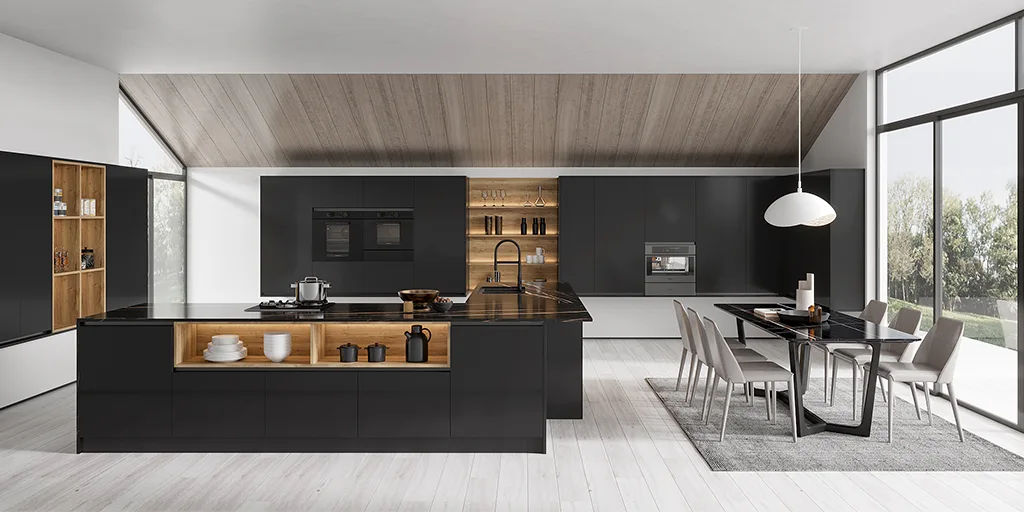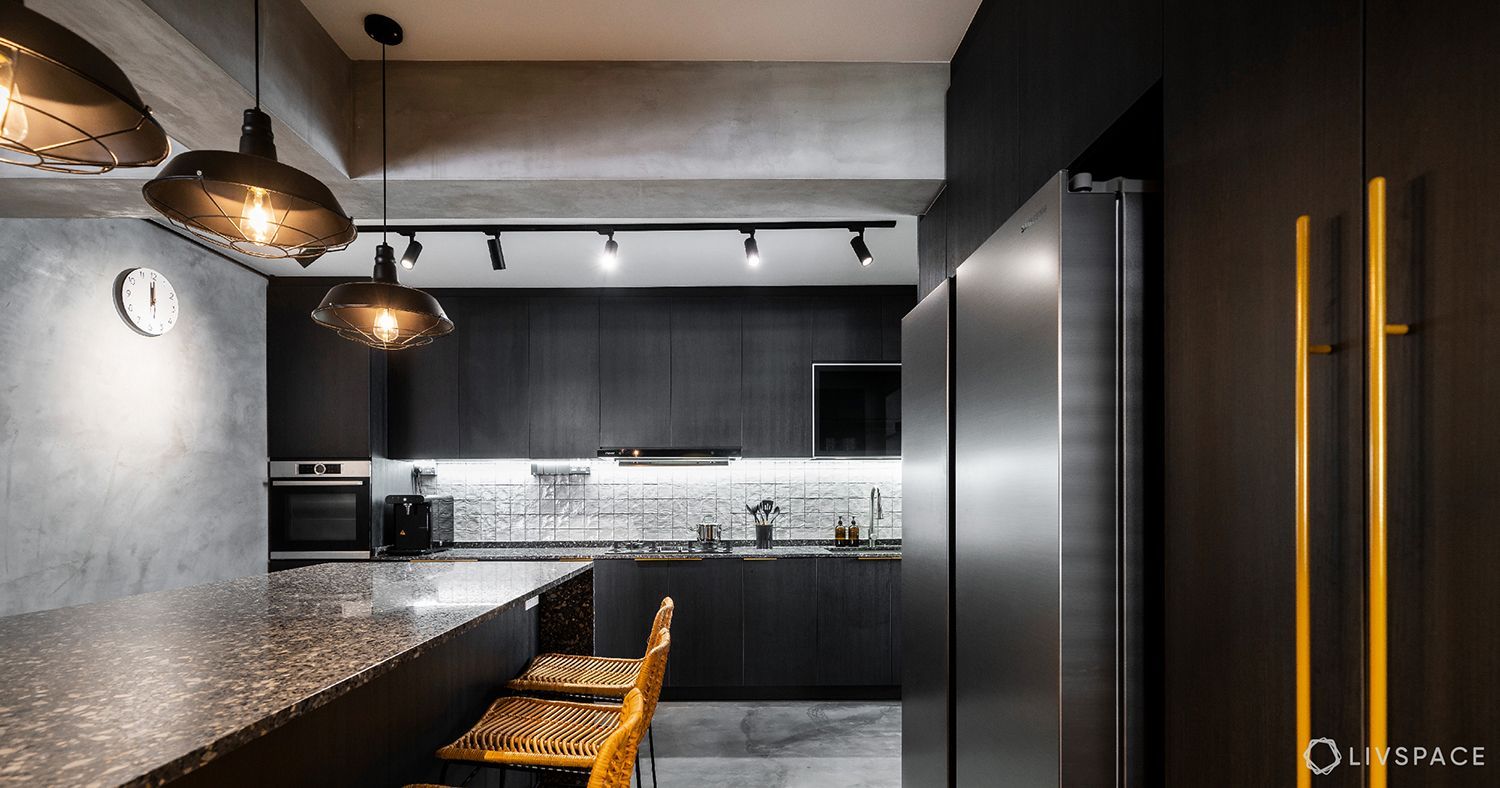Looking for lighting ideas for over the kitchen? Consider pendant lights, recessed lighting, and under-cabinet lighting for a stylish and functional space.
The right lighting can enhance the ambiance, improve functionality, and create a welcoming atmosphere in your kitchen. Whether you’re looking to update your existing lighting or planning a new kitchen design, there are numerous options to consider. From task lighting for food preparation areas to ambient lighting for a cozy atmosphere, the right combination can transform your kitchen into the heart of your home.
We’ll explore various kitchen lighting ideas that can elevate the overall look and feel of your space while meeting your practical needs.
:max_bytes(150000):strip_icc()/outdoorkitchentilebacksplash-54e0cf08168c4b4f9107b35a62a0c395.jpg)
Credit: www.realsimple.com
1. Types Of Kitchen Lighting
Discover a range of captivating kitchen lighting ideas to enhance your space. From pendant lights to recessed lighting, explore different types of kitchen lighting to illuminate your culinary haven with style and functionality.
When it comes to creating a well-lit and inviting kitchen, choosing the right lighting is key. Different types of lighting can serve various functions and enhance the overall ambiance. Here, we’ll explore three popular types of kitchen lighting to help you make an informed decision for your space:
1.1 Recessed Lighting
Recessed lighting, also known as can lights or downlights, is a sleek and minimalist option for the kitchen. These small fixtures are installed into the ceiling, creating a seamless and clutter-free look. Recessed lighting offers a focused and evenly distributed illumination, making it perfect for general lighting needs. It provides ample visibility for cooking, cleaning, and other kitchen tasks. Incorporating dimmable recessed lights can also enhance the mood and ambiance of your kitchen. Whether it’s a modern or traditional kitchen, recessed lighting is a versatile choice that complements various styles.
1.2 Pendant Lighting
Pendant lighting adds a touch of elegance and personality to any kitchen. These suspended fixtures are available in a range of designs, materials, and sizes, allowing you to find the perfect fit for your space. Pendant lights are often used as decorative elements and focal points, making them an excellent choice for kitchen islands, dining areas, or above the sink. They provide task lighting, casting focused light onto specific areas, while also adding a warm and cozy ambiance. Whether you prefer a contemporary look or a vintage-inspired design, pendant lighting can instantly elevate the style of your kitchen.
1.3 Under Cabinet Lighting
Under-cabinet lighting is a practical and discreet option that enhances both functionality and aesthetics in the kitchen. These lights are installed underneath the cabinets, illuminating the countertop area. They offer task lighting, ensuring proper visibility for food preparation and cooking. Under cabinet lighting also adds depth and dimension to the kitchen, particularly when combined with other types of lighting. LED strip lights are the most popular choice for under-cabinet lighting due to their energy efficiency and versatility. Whether you have limited natural light or want to highlight your beautiful countertops, under-cabinet lighting is an excellent solution.
In conclusion, understanding the different types of kitchen lighting and their benefits can help you choose the best lighting for your kitchen. Recessed lighting provides focused and even illumination, pendant lighting adds elegance and personality, while under-cabinet lighting enhances functionality and aesthetics. By carefully selecting and combining these lighting options, you can create a well-lit and inviting kitchen that suits your needs and style. So, what type of lighting is best for your kitchen? It ultimately depends on your preferences, the layout of your kitchen, and the ambiance you wish to achieve.
2. Functional Lighting Solutions
2. Functional Lighting Solutions
When it comes to kitchen lighting, it’s essential to consider both functionality and aesthetics. Functional lighting solutions play a crucial role in creating a well-lit and efficient kitchen space. By incorporating different types of lighting, you can enhance both the practicality and visual appeal of your kitchen.
2.1 Task Lighting
Task lighting is the ideal lighting solution for focused activities such as food preparation and cooking. It provides bright and direct illumination in specific work areas, ensuring optimal visibility and minimizing eye strain. To achieve the best results, install under-cabinet LED strips or pendant lights above the kitchen island or countertop. This type of lighting is best for a kitchen brightened up with proper illumination.
2.2 Ambient Lighting
Ambient lighting serves as the primary source of light within the kitchen and creates a warm and inviting atmosphere. It ensures overall illumination and helps eliminate any dark corners in the space. Incorporate ceiling-mounted fixtures or recessed lights to achieve uniform brightness throughout the kitchen. Ambient lighting is the best solution for a dull kitchen that needs even and balanced light distribution.
2.3 Accent Lighting
Accent lighting is used to highlight specific architectural features, decorative elements, or valuable kitchen items. This type of lighting adds a touch of drama and visual interest to the space. Consider using track lights or LED strips to illuminate shelves, artwork, or architectural details. Accent lighting enhances the aesthetic appeal of the kitchen and is the best option for kitchen spots that you want to highlight and showcase.
3. Creative Lighting Fixtures
When it comes to creating a well-lit and inviting kitchen space, experimenting with creative lighting fixtures can make all the difference. Whether you are looking to add a touch of elegance or to enhance the functionality of your kitchen, there are various options to consider. From chandeliers to track lighting, each fixture brings its unique charm and practicality to the kitchen.
3.1 Chandeliers
Chandeliers are not just for dining rooms and grand entryways; they can also bring a sense of luxury and grace to your kitchen. What type of lighting is best for a kitchen? Chandeliers offer ambient lighting that fills the entire space with a warm glow, making them an excellent choice for creating a cozy atmosphere for family gatherings or entertaining guests. Is your kitchen feeling a bit dull and uninspiring? Installing a chandelier can instantly uplift the ambiance and add a touch of sophistication to the room.
3.2 Track Lighting
If you are unsure about how to light your kitchen properly, consider incorporating track lighting. What is the best lighting for a dull kitchen? Track lighting allows you to direct light precisely where it’s needed, making it an ideal solution for illuminating specific areas such as countertops, islands, or kitchen workstations. Its adjustable nature provides flexibility in lighting design and can be used for both ambient and task lighting. How should I light my kitchen? With track lighting, you can tailor the illumination according to your kitchen’s layout and specific requirements, ensuring that every corner is well-lit.
3.3 Island Lighting
For kitchens with islands or breakfast bars, island lighting serves as a focal point while also offering practical task lighting. What is the best light for kitchen spots? Pendant lights are commonly used for illuminating kitchen islands, as they provide targeted lighting for food preparation and casual dining. These fixtures come in various shapes, sizes, and styles, allowing you to match them with your kitchen’s aesthetic. How should I light my kitchen? Positioning pendant lights above the island not only enhances the visual appeal of the space but also ensures that it remains well-lit and functional for various activities.

Credit: www.oppoliahome.com
4. Energy-efficient Lighting
When it comes to lighting up your kitchen efficiently, there are several smart choices that not only brighten up your space but also reduce energy consumption. By opting for energy-efficient lighting solutions, you can minimize your carbon footprint while enjoying well-lit and inviting surroundings.
4.1 Led Lighting
LED lighting has gained immense popularity in recent years, and for good reason. This energy-efficient lighting option offers numerous benefits, making it an ideal choice for any kitchen.
LED lights are long-lasting and durable, with lifespans that can reach up to 50,000 hours. These lights also consume significantly less energy compared to traditional incandescent bulbs, resulting in lower electricity bills.
Another advantage of LED lighting is that it emits very little heat, making it safe to use in the kitchen. It is also available in a range of color temperatures, allowing you to create the perfect ambiance for your cooking and dining areas.
What type of lighting is best for a kitchen? LED lighting is undoubtedly a top choice when it comes to energy efficiency and longevity.
4.2 Sensor-activated Lighting
Sensor-activated lighting has revolutionized the way we illuminate our kitchens. These lights are equipped with motion sensors that automatically turn on when someone enters the room and off when there’s no movement detected.
By installing sensor-activated lighting in your kitchen, you can save energy by ensuring that lights are only on when needed. This feature is especially useful in busy households where family members may forget to switch off lights after leaving the kitchen.
What is the best lighting for a dull kitchen? Sensor-activated lighting can instantly brighten up a dull kitchen without the need for constant manual operation.
4.3 Smart Lighting Systems
Smart lighting systems combine convenience and energy efficiency by allowing you to control your kitchen lights remotely using your smartphone or voice commands. These systems typically utilize LED bulbs and offer a wide range of features, such as dimming capabilities, color-changing options, and scheduling.
With a smart lighting system, you can easily adjust the brightness and color of your kitchen lights to match your activities and mood. In addition to enhancing the overall aesthetics of your kitchen, these systems enable you to save energy by optimizing light output based on your specific needs.
How should I light my kitchen? Smart lighting systems provide a versatile and customizable solution for lighting up your kitchen, ensuring you have the best light for kitchen spots.
By incorporating energy-efficient lighting options into your kitchen, you can create a well-lit and eco-friendly space. LED lighting, sensor-activated lighting, and smart lighting systems offer practical and stylish solutions for any kitchen, making your cooking and dining experience more enjoyable while reducing your environmental impact.
5. Lighting Design Tips
If you’re looking to create the perfect ambiance in your kitchen, the lighting design plays a key role. By strategically incorporating different lighting elements, you can transform your kitchen into a warm and inviting space that is both functional and visually appealing. In this section, we will explore five essential lighting design tips to elevate your kitchen’s aesthetic.
5.1 Layering Of Lighting
Layering your kitchen lighting is essential for achieving a balanced and well-lit space. This technique involves combining various lighting sources to create multiple layers of light, resulting in a more dynamic and inviting atmosphere.
Consider incorporating three main layers of lighting:
- Ambient Lighting: This acts as the primary light source and sets the overall tone of the room. To achieve uniform illumination throughout the kitchen, you can install ceiling fixtures, recessed lights, or track lighting.
- Task Lighting: This type of lighting is focused on illuminating specific areas where you perform tasks, such as the countertops, stove, or sink. Under-cabinet lights, pendant lights, or adjustable spotlights are excellent options for task lighting.
- Accent Lighting: Adding accent lighting creates visual interest and highlights particular elements, such as artwork, glassware, or architectural features. You can use track lights, wall sconces, or display cabinet lighting to accentuate these areas.
5.2 Choosing The Right Bulbs
When it comes to selecting bulbs for your kitchen lighting, there are a few factors to consider. First, determine the color temperature of the bulbs to ensure they complement the atmosphere you want to create. Cooler tones, such as daylight white, work best for task-oriented areas, while warmer tones, such as soft white or warm white, create a cozy feel in the overall space.
Additionally, energy-efficient LED bulbs are a popular choice as they provide bright, long-lasting illumination while reducing energy consumption. They are also available in various shapes and sizes, allowing you to choose the best fit for your fixtures.
5.3 Creating A Focal Point
Adding a focal point to your kitchen not only enhances the overall design but also draws attention to specific areas. Incorporating lighting elements that serve as focal points can elevate the visual appeal and create a wow factor. Consider installing an eye-catching chandelier above the kitchen island or pendant lights above a dining nook to create a striking focal point that ties the whole space together.
Remember, it’s important to strike a balance between functionality and aesthetics when designing your kitchen lighting. By implementing these lighting design tips, you can create a well-lit and visually appealing kitchen that suits your needs and personal style.

Credit: www.livspace.com
Frequently Asked Questions lighting ideas for over the kitchen
What Is The Best Lighting To Have In A Kitchen?
The best lighting for a kitchen is a combination of ambient, task, and accent lighting. Ambient lighting provides overall illumination, task lighting helps with food prep and cooking, and accent lighting adds visual interest. Use a mix of pendant lights, under-cabinet lighting, and recessed lights for a well-lit kitchen.
What Is The Most Effective Kitchen Lighting?
The most effective kitchen lighting is LED recessed lights or under cabinet lighting. They provide even illumination and reduce shadows for better visibility and ambiance. Choose LED bulbs for energy efficiency. Position the lights strategically for the task and ambient lighting.
What Is The Best Lighting For A Dull Kitchen?
The best lighting for a dull kitchen is LED lights. They are energy-efficient, bright, and have a long lifespan. They can be installed under cabinets, on the ceiling, or as pendant lights to improve overall brightness and visibility in the kitchen.
How Do You Properly Light A Kitchen?
Properly lighting a kitchen involves following these 5 guidelines:
1. Install task lights under cabinets for better visibility.
2. Use pendant lights above the workspace for focused lighting.
3. Add ambient lighting with ceiling fixtures to create a warm atmosphere.
4. Consider LED lights for energy efficiency and brightness.
5. Utilize dimmers to control the intensity of the light.
What Are The Different Types Of Kitchen Lighting?
There are several types of kitchen lighting to choose from, including recessed lights, pendant lights, and under-cabinet lights.
Conclusion
To transform your kitchen into a well-lit and inviting space, incorporating these kitchen lighting ideas is essential. From pendant lights to under-cabinet lighting, these options not only enhance functionality but also add style and ambiance. Don’t forget to consider the natural light sources and utilize dimming features for versatile lighting.
By implementing these tips, you can create a cozy and efficient kitchen that suits your personal style. Happy lighting!










